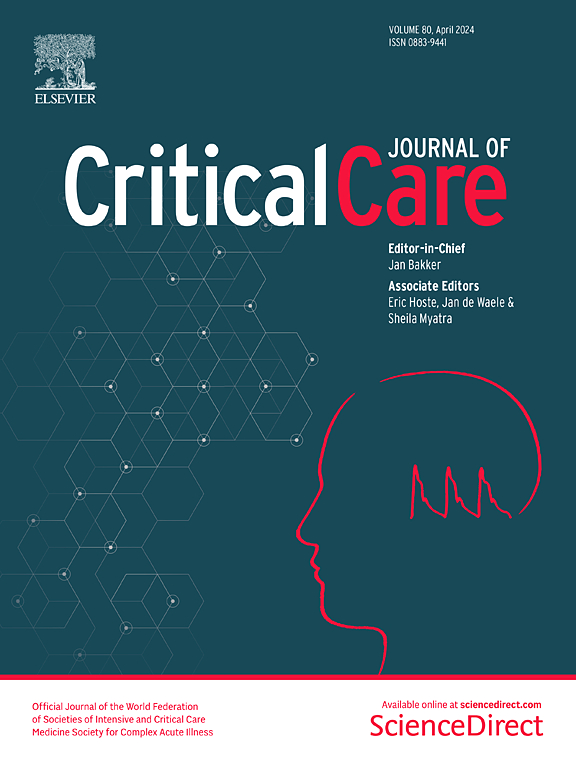Post-insufflation diaphragm contractions in patients receiving various modes of mechanical ventilation
IF 9.3
1区 医学
Q1 CRITICAL CARE MEDICINE
引用次数: 0
Abstract
During mechanical ventilation, post-insufflation diaphragm contractions (PIDCs) are non-physiologic and could be injurious. PIDCs could be frequent during reverse-triggering, where diaphragm contractions follow the ventilator rhythm. Whether PIDCs happens with different modes of assisted ventilation is unknown. In mechanically ventilated patients with hypoxemic respiratory failure, we aimed to examine whether PIDCs are associated with ventilator settings, patients’ characteristics or both. One-hour recordings of diaphragm electromyography (EAdi), airway pressure and flow were collected once per day for up to five days from intubation until full recovery of diaphragm activity or death. Each breath was classified as mandatory (without-reverse-triggering), reverse-triggering, or patient triggered. Reverse triggering was further subclassified according to EAdi timing relative to ventilator cycle or reverse triggering leading to breath-stacking. EAdi timing (onset, offset), peak and neural inspiratory time (Tineuro) were measured breath-by-breath and compared to the ventilator expiratory time. A multivariable logistic regression model was used to investigate factors independently associated with PIDCs, including EAdi timing, amplitude, Tineuro, ventilator settings and APACHE II. Forty-seven patients (median[25%-75%IQR] age: 63[52–77] years, BMI: 24.9[22.9–33.7] kg/m2, 49% male, APACHE II: 21[19–28]) contributed 2 ± 1 recordings each, totaling 183,962 breaths. PIDCs occurred in 74% of reverse-triggering, 27% of pressure support breaths, 21% of assist-control breaths, 5% of Neurally Adjusted Ventilatory Assist (NAVA) breaths. PIDCs were associated with higher EAdi peak (odds ratio [OR][95%CI] 1.01[1.01;1.01], longer Tineuro (OR 37.59[34.50;40.98]), shorter ventilator inspiratory time (OR 0.27[0.24;0.30]), high peak inspiratory flow (OR 0.22[0.20;0.26]), and small tidal volumes (OR 0.31[0.25;0.37]) (all P ≤ 0.008). NAVA was associated with absence of PIDCs (OR 0.03[0.02;0.03]; P < 0.001). Reverse triggering was characterized by lower EAdi peak than breaths triggered under pressure support and associated with small tidal volume and shorter set inspiratory time than breaths triggered under assist-control (all P < 0.05). Reverse triggering leading to breath stacking was characterized by higher peak EAdi and longer Tineuro and associated with small tidal volumes compared to all other reverse-triggering phenotypes (all P < 0.05). In critically ill mechanically ventilated patients, PIDCs and reverse triggering phenotypes were associated with potentially modifiable factors, including ventilator settings. Proportional modes like NAVA represent a solution abolishing PIDCs.接受各种机械通气模式的患者吸气后横膈膜收缩的情况
在机械通气过程中,吸气后横膈膜收缩(PIDC)是非生理现象,可能会造成伤害。在反向触发时,膈肌收缩会跟随呼吸机的节律,因此 PIDCs 可能会频繁发生。不同的辅助通气模式是否会发生 PIDC 尚不清楚。在低氧血症呼吸衰竭的机械通气患者中,我们旨在研究 PIDC 是否与呼吸机设置、患者特征或两者都有关联。从插管到膈肌活动完全恢复或死亡的长达五天的时间里,我们每天收集一次膈肌电图(EAdi)、气道压力和气流的一小时记录。每次呼吸被分为强制性(无反向触发)、反向触发或患者触发。根据相对于呼吸机周期的 EAdi 时间或导致呼吸堆积的反向触发,对反向触发进行了进一步分类。逐次测量 EAdi 时间(起始、偏移)、峰值和神经吸气时间(Tineuro),并与呼吸机呼气时间进行比较。采用多变量逻辑回归模型研究与 PIDCs 独立相关的因素,包括 EAdi 时间、振幅、Tineuro、呼吸机设置和 APACHE II。47名患者(中位数[25%-75%IQR]年龄:63[52-77]岁,体重指数:24.9[22.9-33.7]kg/m2,49%为男性,APACHE II:21[19-28])每人提供了2 ± 1次记录,共计183,962次呼吸。74%的反向触发呼吸、27%的压力支持呼吸、21%的辅助控制呼吸、5%的神经调节通气辅助呼吸发生了 PIDC。PIDC 与更高的 EAdi 峰值(几率比 [OR][95%CI] 1.01[1.01;1.01])、更长的 Tineuro(OR 37.59[34.50;40.98])、更短的呼吸机吸气时间(OR 0.27[0.24;0.30])、高吸气峰值流量(OR 0.22[0.20;0.26])和小潮气量(OR 0.31[0.25;0.37])(所有 P 均≤0.008)。NAVA 与无 PIDCs 相关(OR 0.03[0.02;0.03]; P <0.001)。反向触发的特点是 EAdi 峰值低于在压力支持下触发的呼吸,并且与辅助控制下触发的呼吸相比,潮气量较小,设定吸气时间较短(均 P < 0.05)。与所有其他反向触发表型相比,导致呼吸叠加的反向触发的特点是 EAdi 峰值更高、Tineuro 时间更长,并与潮气量小有关(所有 P < 0.05)。在重症机械通气患者中,PIDC 和反向触发表型与潜在的可调节因素有关,包括呼吸机设置。NAVA 等比例模式是消除 PIDC 的一种解决方案。
本文章由计算机程序翻译,如有差异,请以英文原文为准。
求助全文
约1分钟内获得全文
求助全文
来源期刊

Critical Care
医学-危重病医学
CiteScore
20.60
自引率
3.30%
发文量
348
审稿时长
1.5 months
期刊介绍:
Critical Care is an esteemed international medical journal that undergoes a rigorous peer-review process to maintain its high quality standards. Its primary objective is to enhance the healthcare services offered to critically ill patients. To achieve this, the journal focuses on gathering, exchanging, disseminating, and endorsing evidence-based information that is highly relevant to intensivists. By doing so, Critical Care seeks to provide a thorough and inclusive examination of the intensive care field.
 求助内容:
求助内容: 应助结果提醒方式:
应助结果提醒方式:


